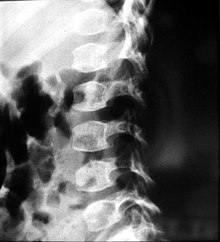| This article needs more reliable medical references for verification or relies too heavily on primary sources. Please review the contents of the article and add the appropriate references if you can. Unsourced or poorly sourced material may be challenged and removed. Find sources: "Spondyloepiphyseal dysplasia congenita" – news · newspapers · books · scholar · JSTOR (June 2019) |  |
| Spondyloepiphyseal dysplasia congenita | |
|---|---|
| Specialty | Medical genetics |
Spondyloepiphyseal dysplasia congenita (abbreviated to SED more often than SDC) is a rare disorder of bone growth that results in dwarfism, characteristic skeletal abnormalities, and, in some instances, problems with vision and hearing. The name of the condition indicates that it affects the bones of the spine (spondylo-) and the ends of bones (epiphyses), and that it is present from birth (congenital). The signs and symptoms of spondyloepiphyseal dysplasia congenita are similar to, but milder than, the related skeletal disorders achondrogenesis type 2 and hypochondrogenesis. Spondyloepiphyseal dysplasia congenita is a subtype of collagenopathy, types II and XI.
Presentation
People with spondyloepiphyseal dysplasia are short-statured from birth, with a very short trunk and neck and shortened limbs. Their hands and feet, however, are usually average-sized. This type of dwarfism is characterized by a normal spinal column length relative to the femur bone. Adult height ranges from 0.9 meters (35 inches) to just over 1.4 meters (55 inches). Curvature of the spine (such as kyphoscoliosis and lordosis) progresses during childhood and can cause problems with breathing. Changes in the spinal bones (vertebrae) in the neck may also increase the risk of spinal cord damage. Other skeletal signs include flattened vertebrae (platyspondyly), a hip joint deformity in which the upper leg bones turn inward (coxa vara), and an inward- and downward-turning foot (called clubfoot). Decreased joint mobility and arthritis often develop early in life. Medical texts often state a mild and variable change to facial features, including cheekbones close to the nose appearing flattened, although this appears to be unfounded. Some infants are born with a cleft palate. Severe nearsightedness (high myopia) is sometimes present, as are other eye problems that can affect vision such as detached retinas. About one-quarter of people with this condition have mild to moderate hearing loss.
Causes

Spondyloepiphyseal dysplasia congenita is one of a spectrum of skeletal disorders caused by mutations in the COL2A1 gene. The protein made by this gene forms type II collagen, a molecule found mostly in cartilage and in the clear gel that fills the eyeball (the vitreous). Type II collagen is essential for the normal development of bones and other connective tissues. Mutations in the COL2A1 gene interfere with the assembly of type II collagen molecules, which prevents bones from developing properly and causes the signs and symptoms of this condition.
Spondyloepiphyseal dysplasia congenita is inherited in an autosomal dominant pattern, which means one copy of the altered gene is sufficient to cause the disorder.
Management
There is no treatment for the underlying condition. Supportive/symptomatic treatment is based on the traits present in each person with the condition.
Notable people
- Michael Dunn, Oscar- and Tony-nominated American actor, The Wild Wild West, Star Trek
- Warwick Davis, English actor and TV presenter, Willow, Return of the Jedi, Leprechaun film series. His two children also have SED.
- Lenny Rush, English actor, Am I Being Unreasonable?
- Natalia Grace, Ukrainian-born American with dwarfism, The Curious Case of Natalia Grace
- Alexander Katan, Dutch Jewish accountant, teacher, and translator who was murdered by the Nazis during the Holocaust, photos of him were notoriously on display in various museums.
References
- "Spondyloepiphyseal dysplasia congenita | Genetic and Rare Diseases Information Center (GARD) – an NCATS Program". rarediseases.info.nih.gov. Archived from the original on 2 June 2019. Retrieved 2 June 2019.
- Reference, Genetics Home. "Spondyloepiphyseal dysplasia congenita". Genetics Home Reference. Retrieved 20 March 2020.
 This article incorporates text from this source, which is in the public domain.
This article incorporates text from this source, which is in the public domain.
- Reference, Genetics Home. "Spondyloepiphyseal dysplasia congenita". Genetics Home Reference. Retrieved 3 June 2019.
- "Spondyloepiphyseal Dysplasia, Congenital". NORD (National Organization for Rare Disorders). Retrieved 20 March 2020.
- Spranger: Bone Dysplasias, Urban & Fischer 2002, ISBN 3-437-21430-6
Further reading
- GeneReviews/NIH/NCBI/UW entry on X-Linked Spondyloepiphyseal Dysplasia Tarda
- OMIM entries on X-Linked Spondyloepiphyseal Dysplasia Tarda
External links
| Classification | D |
|---|---|
| External resources |
| Diseases of collagen, laminin and other scleroproteins | |||||||||||||||||||||||||||||
|---|---|---|---|---|---|---|---|---|---|---|---|---|---|---|---|---|---|---|---|---|---|---|---|---|---|---|---|---|---|
| Collagen disease |
| ||||||||||||||||||||||||||||
| Laminin | |||||||||||||||||||||||||||||
| Other | |||||||||||||||||||||||||||||
| see also fibrous proteins | |||||||||||||||||||||||||||||